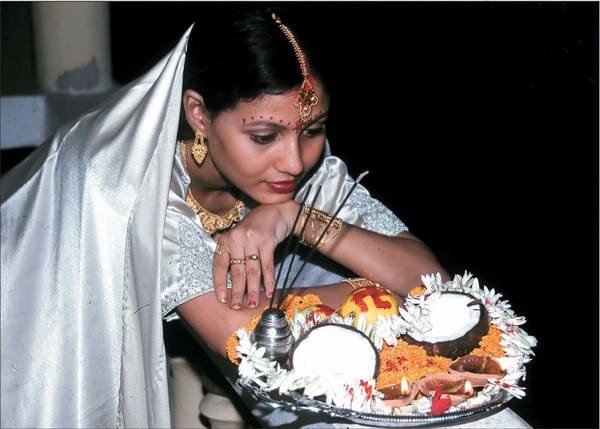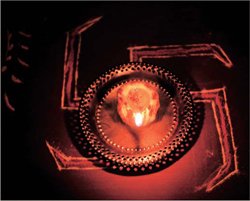
Dipavali: devotee contemplates her offering tray and sacred lamps;
• • • • • • • • • • • • • • • • • • • • • • •§
COMMENTARY
The Inner Light
________________§
Amidst the parties and fireworks, let us
not forget the real meaning of Dipavali
________________§
B Y R A M A D E V A G U P T A§
 FROM FALSEHOOD LEAD ME TO TRUTH, FROM DARKNESS lead me to light, from death lead me to immortality.” Nowhere else is the symbolism of these lines from the Brihadaranyaka Upanishad better expressed than in the celebration of Dipavali. Popularly known as the Festival of Lights and abbreviated to Diwali in contemporary usage, Dipavali is the most important festival for the world’s Hindu population. With its arrays of lighted lamps, firecrackers and festivities, Dipavali transforms the desolate, fall moonless skies by filling them with laughter, happiness and radiance.§
FROM FALSEHOOD LEAD ME TO TRUTH, FROM DARKNESS lead me to light, from death lead me to immortality.” Nowhere else is the symbolism of these lines from the Brihadaranyaka Upanishad better expressed than in the celebration of Dipavali. Popularly known as the Festival of Lights and abbreviated to Diwali in contemporary usage, Dipavali is the most important festival for the world’s Hindu population. With its arrays of lighted lamps, firecrackers and festivities, Dipavali transforms the desolate, fall moonless skies by filling them with laughter, happiness and radiance.§
Like other religious festivals of the world, Dipavali is associated with several different legends and has deep social and spiritual significance. It is primarily known for the worship of the Goddess Lakshmi, who symbolizes wealth and prosperity. In North India, it is a commemoration of Lord Rama’s triumphant return to Ayodhya after vanquishing the forces led by Ravana. In South India, Dipavali is celebrated in remembrance of Lord Krishna’s victory over Narakasura. In addition, it marks the end of the rainy season and the harvesting cycle, and therefore it is also the festival of the Kharif or new crop. §
Whichever story one might prefer, Dipavali celebrations all over the world are universally marked by majestic fireworks, a variety of cultural programs, a spirit of sharing and brotherhood, and, most importantly, the lighting of lamps (dipas) in several rows (vali) inside and outside the house. It is these luminous dipas that contain the essence of Dipavali. Just as light dispels the darkness of the night and shows the right path to a weary traveler, the lighting of lamps on the night of Karttik Amavasya, when the new moon is in Tula or Libra, symbolizes the victory of goodness over evil, justice over injustice, light over darkness and wisdom over ignorance. §
Since the beginning of time, spiritual aspirants have sought light as the culmination of their journey. What is this internal, divine light of which the dipas on Dipavali night, or those set before the family deity during morning and evening prayers, are only an external representation?§
One of the most illustrious conversations on this subject can be found in the Brihadaranyaka Upanishad, wherein King Janaka of Videha, whose courtroom was famed for spiritual discussions conducted by the most distinguished rishis of his time, once asked of Sage Yajnavalkya: “Revered Sage, enlighten me! What is the light of man? What is it that allows him to function in this world?” §
Yajnavalkya gave a simple and straightforward answer. “The sun is his light, O King!” he said. “If there were no sunlight, people would be unable to perform their duties in this world. By the light of the sun activity is possible, and it is by the light of the sun that one sits, moves about, completes all work and becomes content.” In a series of questions, Janaka presses the sage on the issue, finally asking what light there would be in the absence of all external manifestations. Yajnavalkya gave a very revealing answer. “O King Janaka!” he said. “Know that when everything else fails, the Soul, the inner Self, will be the guide. It is the Self that will be the light.”§
This light, which is equated with the Supreme and supposed to be the consciousness of life, is expressed as follows in the Chandogya Upanishad (3.13.7): “There is a Light that shines beyond all things on Earth, beyond us all, beyond the heavens, beyond the highest, the very highest, heavens. This is the Light that shines in our heart.”§
Unfortunately, we are oblivious to it most of the time. Even when we read and hear about its presence, we are unable to see the Light, mainly because this flame, which the Vedas say is tinier than the tiniest of atomic sparks and hidden in the innermost chamber of the human heart, is now covered by layers of grossness, complexities and impressions. Also, due to our outward-turning senses, tendencies and attachments to the fruits of action, we are unable to turn our eyes inward—at least not until compelled by external circumstances. But we must be able to do so somehow, if the lower self is to become one with the Ultimate Being. But this union is not as easy as it appears in words. The journey is filled with obstacles: darkness and ignorance, misleading visions.§
In Arjuna’s vision of Lord Krishna in His Cosmic Form on the battlefield of Kurukshetra, the experience of the transcendental Reality is associated with brilliance, splendor and light: “If a thousand suns should rise all at once in the sky, such splendor would resemble the splendor of that great Being…. Then Arjuna, who was filled with amazement, whose hair was standing on end, bowing his head to the Lord with joined palms, said: … ‘With infinite power, without beginning, middle or end, with innumerable arms, the Moon and Sun being Your eyes, I see You, the blazing fire Your mouth, burning all this universe with Your radiance.’”§
Fascinating and awesome as such visions might be, even the experience of light ought not be the final goal. If that were so, the Bhagavad Gita would have ended with the Eleventh Teaching. But it does not. According to Krishna Himself, the supreme state is that which the Sun does not illumine, nor the Moon, nor the fire, for it is the Light of Pure Consciousness. These words are analogous to those found in the Svetasvatara (6.14) and Katha Upanishad (5.15). “There the Sun shines not, nor the Moon, nor the stars; lightnings shine not there and much less earthly fire. From His light all these give light, and His radiance illumines all creation.”§
In the modern era, Shri Ram Chandra of Shahjahanpur for almost fifty years taught meditation on the “divine light in the heart,” according to the Sahaj Marg system of Raja Yoga. In Voice Real, he writes, “Every saint has used the word light … and that is the best expression for Reality. But that creates some complication, because when we talk of light, the idea of luminosity becomes prominent, and we begin to take it as glittering. The Real Light carries with it no such sense and may be represented as ‘light without luminosity.’ It refers only to the real substance or, more appropriately, to ‘substanceless substance,’ which is associated with neither light nor darkness, but beyond both.”§

Traditional clay lamp is set upon the drawing of a swastika and other auspicious symbols made with colored rice flour§
It is painfully evident that words and descriptions of spiritual Light can convey only so much. As Babuji says, understanding comes by intuitive capacity and practical experience in the spiritual field. §
We should be celebrating the Festival of Lights in renewal of our quest for that spiritual Light. But today, few, if any, attach such reverence to the occasion. Instead, it has become a night of entertainment, gambling, pleasure and consumption. Just as the candles and electric lights of modern society have gradually replaced the traditional dipas, the focus of the prayers has shifted from the journey from darkness to light to the quest for fortune and wealth. §
To appreciate the spirit behind this festival and pass on its significance to others, one needs only to consider the traditional lamps that are popular even today in the small towns and villages of India. These dipas represent the four essential elements that are required in the seeker: detachment (the clay container), devotion to the Lord (the oil), prayer and meditation (the cotton wick), and spiritual wisdom (the matchstick to light the lamp). It is noteworthy that on Dipavali the first lamp is lit with a matchstick, after which that lamp is used to light the whole array of lamps inside and outside the house. The first lamp symbolizes divine effulgence, while the other lighted lamps represent the light in individual hearts. Together, they reiterate the eternal truth pronounced in the Vedas: “The One willed to become the Many.” §
As the flames of all these lamps burn brightly and reach upward through the entire night, they show the possibility that, with the removal of darkness, grossness and ignorance, the tiny flickering light in our hearts can also shine brightly, illumining the whole universe. May we all progress speedily to the highest levels of spirituality—from darkness to light, and beyond. §
 Rama Devagupta, Ph.D. in bioorganic chemistry from Texas A&M University, is a full-time mother and freelance writer on parenting issues and spirituality. She teaches the Sahaj Marg system of Raja Yoga as a preceptor of Shri Ram Chandra Mission (www.srcm.org), and lives in Houston, Texas, with her family.§
Rama Devagupta, Ph.D. in bioorganic chemistry from Texas A&M University, is a full-time mother and freelance writer on parenting issues and spirituality. She teaches the Sahaj Marg system of Raja Yoga as a preceptor of Shri Ram Chandra Mission (www.srcm.org), and lives in Houston, Texas, with her family.§